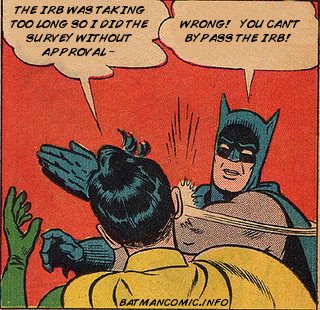 |
| Image from theinsideouteffect.com |
Today we discussed some readings we did on the Pygmalion Effect. This is the notion that preconceived expectations for others impact performance or an outcome, so it's the self-fulfilling prophecy. What's interesting is these preconceived expectations have the same effect whether they are self-generated or imposed by an outside source (though, naturalistic expectations are stronger). So, for example, foremen in a warehouse were told certain employees did good or bad on an exam for the job (regardless of how good or bad they actually did), and the foremen rated those employees who they believed to be smarter as better and more efficient. Another study experimented on mice (I am not a fan of this, but...) where mice were either lesioned through lobotomy or made to look like they were so mice handlers could not tell the difference. Handlers were told mice were either bright or dull regardless of lobotomy. Unsurprising is that lesion-free mice with handlers led to believe they were bright performed the best. What was surprising was that lesion-free mice with handlers led to believe they were dull performed just as poorly as lesioned mice who were determined to be dull.
We are looking at this research more directly related to classrooms and formal education next week, but there are huge implications. Visual cues in all of this are one of the most important factors. There is a study in psychology of "thin-slicing" (person perception based on superficial aspects in a short period of time.. so, first impressions, essentially) for student perceptions of teachers, where students watched 30 second clips of teachers teaching with no sound and were to rate their effectiveness as a teacher based on that video clip alone. The study found that the students watching the clips had nearly the same ratings of teachers as the students who actually completed the class and filled out TCEs.
Ambady, N., & Rosenthal, R. (1993). Half a minute: Predicting teacher evaluations from thin slices of nonverbal behavior and physical attractiveness. Journal of Personality and Social Psychology,64(3), 431-441.Another (and very recent) study by Chia Jung Tsay did something similar where people would receive short clips with no sound of musicians competing in formal events, and they would need to predict who won based on the videos alone, hearing no sound. Accuracy in guessing was astounding, where visual impressions clearly had a greater impact than actual talent. When participants tried to base their ranking guesses on audio alone, they were not able to distinguish who won. Tsay points out that this "suggests that the visual trumps the audio, even in a setting where audio information should matter much more."
In looking at perception-of-self and perception of librarians by patrons, students, faculty, etc., this is important to think about (and something we are examining in the Librarian Wardrobe book). How we are perceived by others might influence how they evaluate us, and how we perceive others might influence how we evaluate them. If visual cues are especially important, then understanding how we present ourselves, whether in gesturing, other physical movements, or clothing, then studying how we dress and public perceptions would be quite significant.
